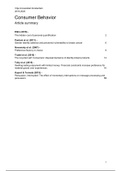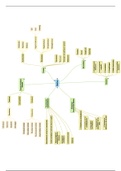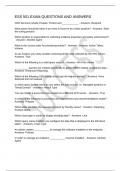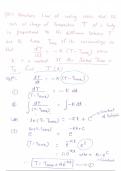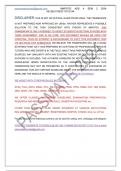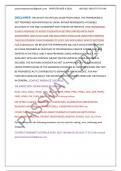2019-2020
Consumer Behavior
Article summary
Etkin (2016) -
The hidden cost of personal quantification 2
Puntoni et al. (2011) -
Gender identity salience and perceived vulnerability to breast cancer 6
Novemsky et al. (2007) -
Preference fluency in choice 9
Trudel et al. (2016) -
The recycled self: Consumers’ disposal decisions of identity-linked products. 12
Tully et al. (2015) -
Seeking lasting enjoyment with limited money: Financial constraints increase preference for
material goods over experiences. 16
Kuport & Tormala (2015) -
Persuasion, Interrupted: The effect of momentary interruptions on message processing and
persuasion. 19
1
,Vrije Universiteit Amsterdam
2019-2020
Etkin (2016) - The hidden cost of personal quantification
Better understanding our behavior, we can make the necessary changes to make our live
happier and healthier lives.
This research examines the unintended negative consequences of personal quantification
(measuring your activity by e.g. a fitbit).
● measuring activity increases how much consumers engage in it (the output);
however, such measurement can decrease intrinsic motivation, reducing how much
the activity is enjoyed (it seems more like work)
● external rewards can undermine (make less effective) the intrinsic motivation.
External incentives & Intrinsic motivation
External incentives are often used to promote desired behavior. However external rewards
can undermine intrinsic motivation. People attribute their reward rather than to personal
interest and thus infer that they do the activity to receive the reward rather than because
they like it (instrumental instead of valuable → reduces enjoyment).
The impact of measurement
Etkin proposes that even in the absence of explicit external incentives, measurement itself
can have similar effects.
measurement → “feedback about behavioral output, or how much of an activity a consumer
has done”.
Even without external rewards, measurement should lead to more engagement in the activity
(e.g. reading more pages of a book). However, measurement can reduce how much people
enjoy doing an activity.
● activities performed for their external benefits often feel like work
● ‘’ people tend to think about output as work if it is extrinsically motivated compared to
intrinsic motivation ‘’. Even in the absence of external awards, measurement itself
can have negative effects.
● Importantly, the decrease in output should only occur after the measurement is
removed.
Overview of experiments
Experiment 1 - coloring
Experiment 2 & 3 - walking
Experiment 4,5, & 6 - reading
● experiment 4 includes moderation
Experiment 1
“how does measurement impact enjoyment?”
2
,Vrije Universiteit Amsterdam
2019-2020
hypothesis: measurement should lead to increase in coloring, however it would
reduce the enjoyment
Experiment included people coloring shapes. The difference between the control group and
the measurement group is that a monitor in the measurement group showed how many
shapes the participants had colored (measurement). This measurement was absent in the
control group.
Results:
● output → m easurement increased output
● enjoyment → m easurement decreased enjoyment
● creativity → participants in the measurement group were less creative (e.g. # of
colors used in a shape)
Experiment 2
“how does measurement impact the amount walked and how does it influence enjoyment of
the activity”
hypothesis: will increase the amount walked, but decrease enjoyability.
One group was given the option to choose whether they wanted to be measured, the control
group did not receive such an option. The underlying thought is to examine whether people
would choose measurement for an enjoyable activity, and if so, whether it has the same
effects. The control group had to wear a pedometer that was sealed, whereas the
measurement group was able to look at their step-count throughout the day.
Results:
● output : measurement indeed increased the amount of steps walked.
○ it reduced enjoyability even for those participants who voluntarily chose to
be measured. When available, people will choose to be measured, however
it will hurt them.
● enjoyment : measurement reduced enjoyment
It is important to know that the increased output was NOT the reason that people enjoyed
the activity less. Infact output and enjoyment were not correlated and output did not mediate
the effect between measurement and enjoyability.
● doing more of an activity does not reduce enjoyment
Experiment 3
This experiment has 3 objectives
1. does drawing attention to output make the measurement of an enjoyable activity
seem like work? And whether this perception decreases how much participants enjoy
the activity
2. spending time on work activities reduces social well-being. Therefore, measured
enjoyable activities should reduce satisfaction and happy feelings. Is that the case?
3. Are the measurement effects persistent when participants attend to measurement
(voluntarily look at the step count on their pedometer).
3
,Vrije Universiteit Amsterdam
2019-2020
In this experiment there were 3 (control) conditions
1. measurement condition → asked/required to look
2. control condition → sealed pedometers
3. optional measurement condition → no instructions given, they could look at the
pedometer if they wanted to, but it was not required.
Results:
● output → measurement increased output. Measurement increased how much people
walked, even when looking at the pedometer was optional.
● enjoyment → measurement decreased enjoyment even when looking at it was
optional.
● underlying process → attending to measurement feedback made walking seem more
like work. In addition, seeing the activity as more like work drove the negative effect
of measurement on enjoyment.
● consequences for subjective well-being → measurement also reduced subjective
well-being. Participants reported less happiness and satisfaction.
Experiment 3 demonstrates the proposed underlying process driving measurements
negative effect on enjoyment. Finally the results also illustrate a negative downstream
consequence.
Experiment 4
Experiment 4 had 2 main objectives:
1. further tests the underlying process using mediation and moderation. If the
enjoyable activity is perceived work-like, then it reduces enjoyment. However, if the
enjoyable activity is framed as work-like to begin with, then this effect should be less.
(attenuated1).
2. explores consequences of measurement for subjective well being.
This experiment tests the following:
● reading is framed as fun (enjoyment) & reading is framed as work (for learning).
“hypothesis: when framed as fun, measurement would make reading seem more like
work, reducing its enjoyment. However, when framed as work to begin with,
measurement would have less of an effect on how reading is perceived”
Results:
● output → measurement increased how many pages people read. Regardless of how
activities are framed, drawing attention to the output, measurement increases how
much people do.
● enjoyment → measurement reduces enjoyment. However this effect was attenuated
in the work frame condition.
1
attenuate = verzwakken
4
, Vrije Universiteit Amsterdam
2019-2020
● activity framing m
underlying process → oderates measurements effect on
enjoyment.
● consequences for subjective well being → manipulating activity frame moderated
measurement effect on subjective well=being
Experiment 5
1. examines measurements downstream consequences for continued engagement.
Instead of just influencing people's´ enjoyment, undermining intrinsic motivation
reduces how much of an activity people do in the future. Thus, after the
measurement is removed, people should do less of the activity.
Two conditions. Control condition and measurement condition. After reading the book, the
participants answered some questions. After answering those questions, participants went
back to reading the book. The researcher examined how having viewed measurement
before, impacted the amount participants read after the measurement was removed.
In addition, the effect of cognitive load (moderator) was examined. According to the finding,
participants burdened by cognitive load felt less absorbed in the reading compared to their
no-load counterparts.
Results:
● Output → in the measurement group, the number of pages consumers read
increased (as they were measures), however in the cognitive load condition, people
had less attention resources to devote to reading as they had to remember an 8-digit
number. Therefore the output in this condition decreased the number of pages
people read.
● Enjoyment → measurement indeed decreased enjoyment, however this effect was
not significant for the cognitive load condition.
● Consequences for continued engagement → after the measurement was removed,
having viewed measurement previously reduced the number of pages participants
read.
Experiment 6
Differing from experiment 5, experiment 6 examined whether consumers choose to continue
engaging in the activity (instead of how much of an activity a consumer does after the
measurement)
Results:
● Output → measurement increased output
● Enjoyment → measurement decreased enjoyment.
● Consequences for continued engagement → measurement decreased interest in
continuing to read.
Therefore, having viewed measurement before, reduces the choice to engage in it any
further.
General discussion
5

